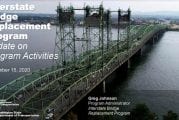Administrator Greg Johnson informs committee members they will be expected to address every issue that was brought up and approved as part of the locally preferred alternative
After Tuesday’s meeting with the 16 committee members from the Oregon and Washington legislatures, Interstate Bridge Replacement Project Administrator Greg Johnson addressed the issue of revising the Purpose and Need statement from the original Columbia River Crossing (CRC).
During Tuesday’s meeting of the 16 legislators, Johnson said the following:

“One of the one of the key issues that you will be hearing is because we had a locally preferred alternative (LPA) approved, the federal government, through Federal Highway Administration and Federal Transit Authority, will be expecting us to address every issue that was brought up and approved as part of the locally preferred alternative,’’ Johnson told the legislators.
“Now that does not limit us to those are the only things that will be in the purpose in need,’’ Johnson added. “But it does mean that we have to go back and look at and say, ‘okay, have those things been addressed by something different that has happened in this time period, since the original Purpose and Need was established.’”
After the meeting, Johnson responded to several questions from Clark County Today, including whether or not the committee was bound to live by the language and details of the original LPA?
“Ultimately, the program must demonstrate how we have met our NEPA Purpose and Need statement,’’ Johnson said. “The Purpose and Need of the Interstate Bridge Replacement program will determine whether the details of the original LPA are appropriate, or if changes are necessary.’’
Johnson was then asked what would be sufficient reasons to be allowed to deviate from the original LPA?
“Because more than three years have passed since the Record of Decision was issued, FHWA and FTA require agencies to re-evaluate the previous NEPA decision before taking any actions,’’ he wrote in his email response. “The re-evaluation requires that we assess changes in the project area, changes in regulations, and changes in project need to provide context for how we are to proceed. As we assess changes, we must address every aspect that was covered in the original Purpose and Need and whether or not changes to the Purpose and Need are warranted. Those changes, along with Vision and Values that the program will establish, will define the reasons why we might deviate from alternatives identified in the previous planning effort.’’
Johnson was then asked how often have major, national projects changed their LPA language after an initial Record of Decision, and have those projects been allowed to proceed with a “new” or significantly revised LPA?
“All federal projects must comply with NEPA, including requirements to re-evaluate with project changes, or with the passage of time,’’ he said. “It is common for major projects to change aspects such as design elements or construction details of the preferred alternative after a Record of Decision is issued. Although they did not change the overall LPA, there were 2 re-evaluations completed for the former CRC project that addressed design changes after the ROD was issued. It is important to note that such changes do require more analysis and further NEPA process.’’
For more information, USDOT maintains guidance for how to evaluate those changes (FHWA’s Environmental Review Toolkit, NEPA Re-Evaluation Joint Guidance for Federal Highway Administration (FHWA), Federal Railroad Administration (FRA) & Federal Transit Administration (FTA), issued on August 13, 2019).
Johnson was then asked what are the chances this new project will not have to fulfill the requirements of the original CRC-defined Record of Decision (ROD) and Locally Preferred Alternative?
“The program will use design work and environmental analysis from the former planning process to inform new program development work needed to complete an updated Purpose and Need, and the Vision and Values that will be established by the IBR program,’’ he said. “While the program is in the early stages of the NEPA process and will need to analyze current technical data to determine how best to supplement previous work, the transportation needs previously identified still exist.
“As part of the planning work to update the Purpose and Need for the IBR program, our federal partners will expect us to evaluate the issues that were identified as part of the approved ROD, including determining to what extent any of the transportation problems have been addressed and if there are new problems that should be taken into consideration,’’ Johnson said.
To read a report on Tuesday’s committee, read:
Bi-state Interstate Bridge legislators get project update





